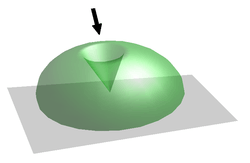Keyhole problem
The keyhole problem, in the context of astronomy, refers to the difficulty that azimuth-elevation type telescopes or antenna gimbal systems encounter in crossing the zenith.
Area of visible sky

To track celestial objects as they move across the sky, these systems usually rotate on two axes. Often, a tilting mechanism (elevation) is mounted upon a panning base (azimuth). To cover the complete hemisphere of visible sky, a telescope gimbal can have a 360-degree azimuth range and a 0- to 90-degree elevation range. To visualize this shape, imagine drawing a quarter circle spanning from the horizon to directly above you and revolving it around the vertical axis. If, on the other hand, the gimbal has a range from 0 to slightly less than 90 degrees elevation, the telescope is unable to see a region of sky.
Gimbal behavior
A variation on the keyhole problem involves defining behavior for gimbals with full-circle azimuth range, and at least 90-degree but less than 180-degree elevation range. Imagine a satellite on an orbital path that crosses directly overhead. If the gimbal tilts to track the object from the horizon but must stop at 90 degrees, the entire telescope must pan 180 degrees to follow the object from zenith down to the opposite horizon. This is an often-encountered difficulty in creating smooth automated tracking algorithms.